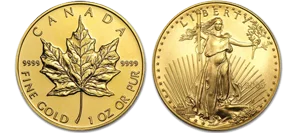Investing in Gold Through a SARSEP
Disclosure: We are reader-supported. If you purchase from a link on our site, we may earn a commission. Learn more
Do you have a SARSEP eligible employer who offers a salary-deferral Simplified Employee Pension (SEP)? These plans are fewer and farther between than most tax-advantaged employer sponsored retirement plans, and it can be difficult for those who still participate in SARSEP plan to find useful information about their options.
If you are looking to add precious metals bullion as a hedge to your retirement portfolio, or are wondering how your retirement account treats gold or silver investments, then you are at the right place. We'll go over what a SARSEP is, how they compare and differ from other retirement plans, how precious metals investing works, and how you can safeguard your retirement assets against stock market and currency collapse.
Table of Contents
What is a SARSEP?
It is possible that many employees have never heard of a SARSEP plan. Beginning the tax year effective January 1, 1997, SARSEPs could no longer be established (in favor of SIMPLE IRA plans), although existing SARSEPs were ‘grandfathered' in and allowed to remain unchanged. These changes were made as a part of the Small Business Job Protection Act of 1996.
SARSEP stands for Salary Reduction Simplified Employee Pension Plan and is a retirement vehicle that was only made available to small businesses with 25 or fewer employees. Under a SARSEP, employees have individual SEP IRAs established in their names and both the employer and the account owner are able to make contributions.
Contributions are pre-tax through salary reductions, and the employer contribution may not exceed either $69,000 for 2024, or 25% of the employee's salary, whichever is less. Additionally, employer contributions are limited by net profits (cannot exceed 25% in net profits in 2024, just like a self-employed SEP IRA).
In short, SARSEP is a collection of SEP IRAs, and individual employee accounts operate through SEP IRA rules (for more on SEP IRAs, visit here)
SARSEP Rollover Rules & Limitations
IRS regulations allow for one rollover or account-to-account transfer from a SAPREP (that is, the individual SEP IRAs within a SARSEP) to an IRA per calendar year without incurring a tax penalty. However, both plans (the receiving and transferring account) must be eligible for facilitating account rollovers.
You don't have to move the entire balance of the SARSEP account, either. If you only want to transfer a portion of your account holdings to, say, an IRA, that's entirely possible without triggering a tax penalty granted you hold yourself to only one transfer per 365-day period.
Note that you might incur an early withdrawal penalty if you're under the age of 59 1/2 years. To avoid this fee, always conduct a direct rollover from one account to another. This way, the money never leaves a tax-sheltered account or appears in your bank account, unlike an indirect rollover. These types of rollovers lower the risk of human error and can help shield you from getting on Uncle Sam's bad side.
SARSEP vs. SEP vs. IRA vs. Other Retirement Accounts
If you want to see how SARSEP accounts measure up against other popular employer-sponsored or independent retirement accounts, check out the chart below.
| Plan Type | Sponsorship | 2025 Contribution Limit | Roth Option? | Allow Gold Stocks? | Allow Gold ETFs? | Allow Gold Bullion |
|---|---|---|---|---|---|---|
| 401(k) | Private Employer | $23,500 | Yes | Maybe | Maybe | No |
| Solo 401(k) | Self-employed | $70,000 | Yes | Yes | Yes | Yes |
| Keogh Plan | Self-employed or Unincorporated Employer | Depends on Type of Plan | No | Maybe | Maybe | No |
| 403(b) | Government or Non-profit Employer | $23,500 | Yes | Maybe | Maybe | No |
| 457(b) | Government or Tax-exempt Employer | $23,500 | Yes | Maybe | Maybe | No |
| SIMPLE IRA | Private Employer | $16,500 | Yes | Yes | Yes | Maybe |
| SEP IRA | Business Owners & Self-employed | $70,000 or 25% of Compensation | Yes | Yes | Yes | Maybe |
| Profit Sharing Plan | Private Employer | $70,000 or 100% of Compensation | No | Maybe | No | No |
| Money Purchase Plan | Private Employer | $70,000 or 25% of Compensation | No | Maybe | Maybe | No |
| Annuity | Individual | None | No | Maybe | Maybe | No |
| ESOP | Private Employer | Varies | Yes | Maybe | No | No |
| SARSEP | Private Employer | $70,000 or 25% of Compensation | No | Yes | Yes | Maybe |
| Traditional IRA | Individual | $7,000 / $8,000 | Yes | Yes | Yes | No |
| Precious Metals IRA | Individual | $7,000 / $8,000 | Yes | Yes | Yes | Yes |
| Thrift Savings Plan (TSP) | Government or Military | $23,500 + $7,500 Catch-up Contribution | Yes | No | No | No |
("Maybe", in this context, indicates that gold investment options may or may not be available depending on the policies of the account custodian.)
Your SARSEP investment choices are limited to what your is written in your employer agreement and what your individual SEP IRA custodian makes available to you. Typically, however, the following asset classes are always made available to SARSEP account holders:
- Individual stocks
- Individual bonds (corporate and government)
- Options
- Mutual fund shares
- Exchange-traded fund (ETF) shares
- Certificates of Deposit (CDs)
- Real estate
- Precious metals bullion
As far as tax-advantaged retirement accounts go, SEP IRAs enjoy relatively laid-back restrictions. There's a wide variety of investment options available to SEP IRA account holders. Some even permit precious metals bullion holdings, but that ultimately is at the discretion of the account custodian.
SARSEPs, through the individual SEP IRA, provide one of the few legitimate means of investing in precious metals in a tax-sheltered environment. Not only can you often hold gold, silver, and platinum in these accounts, but you can also invest in “paper gold” assets. This describes stocks and ETFs representing shares in mining companies whose value are tethered to the spot price of gold, silver, or whatever underlying commodity they're mining.
Investing in Physical Gold vs. ‘Paper Gold'
When you invest in paper gold, you're indirectly exposing your portfolio to the gold or silver market. Although it's not real gold, and does not offer all the same benefits of precious metals investing, it does provide some exposure to the market for investors who otherwise aren't able to hold physical assets.
Paper gold assets are diverse, and often comprise mining stocks as well as companies who are active in the exploration of mining sites or even metal refineries. Leading paper gold stocks including the following:
- Gold Miners Index (GDX)
- BUGS Index (HUI)
- Barrick Gold ($GOLD)
- Franco-Nevada ($FNV)
- Kirkland Lake Gold Ltd. ($KL)
The convenience of gold stocks comes at a cost. Although they're easy to buy and sell on exchanges, the liquidity of gold stocks lends itself well to volatility and hasty sell-offs from investors. Therefore, gold stocks and paper gold are riskier than traditional precious metals bullion.
Liquidity and volatility aren't the only risks associated with paper gold. Below, we've compiled a list of other risk considerations that investors have to bear in mind when investing in paper gold:
- Regulatory Risk – there are few market sectors more closely scrutinized and regulated than the mining sector, and a changing political environment can impose new environmental regulations that can bankrupt a mining company.
- Cost of Production Risk – mining, exploring, and refining is expensive and simple upgrades to equipment can leverage a company to an unsustainable degree.
- Management Risk – new management teams can come in and wreak havoc on a mining company; by contrast, precious metals bullion aren't managed by anyone other than its owner.
- Fiat Currency Risk – gold stocks are purchased with (and sold for) fiat currencies that are vulernable to hyperinflation and other adverse effects of monetary manipulation.
Now, compare these risks to the risks of owning precious metals. Clearly, physical metal ownership wins the battle of risk profiles. While owning gold stocks encompasses significant counterparty risk, precious metals are relatively risk-free and have never hit zero since their early adoption as money.
Should You Dedicate 5-20% of Your Retirement Portfolio to Precious Metals?
The benefits of investing in precious metals are many. For the most part, they offer stability to portfolios that might otherwise be overexposed to stock market volatility. In the event of a recession or stock market collapse similar to the Great Financial Crisis or the Coronavirus Crash of 2020, portfolios with precious metals holdings stand a better chance of weathering the storm than those with stocks and bonds alone.
Not only that, but precious metals are also excellent sources of growth. For the better part of the last decade, both silver and gold have trended upward in price and the coming renewable energy revolution will likely only catalyze the growth of these assets. Why? Because precious metals play an essential role in the creation of solar panels and other critical technologies that green energy sources depend on.
It's less a question of whether you should invest in precious metals, and more a question of by how much. Some leading investors, like Kevin O'Leary, insist on tying up a small portion of one's wealth (i.e., 5-10%) to precious metals, while others advocate for 15 to 20 percent. Ultimately, the closer one is to retirement age the more they have to gain from investing in precious metals. To get started, open a self-directed IRA today.
Ready to invest in precious metals? Not so fast.
These days, we're all worried about the stock market. If we have to face another market crash, our retirements might be delayed by years. Luckily for us, we have the means to protect ourselves. Investing in precious metals is one of the best ways to insulate your retirement portfolio from risk and ensure that you'll withstand the next recession.
Before you get started, consider signing up for our free monthly newsletter. In it, we pack simple, actionable tips about precious metals investing, and include forecasts about where the market's heading next. If you sign up today, we'll also send over a free copy of our ebook 5 Scams to Avoid When Investing in Gold and Silver, which is loaded with insider knowledge to save you money during your diversification process.



 Silver
Silver Gold
Gold Platinum
Platinum Palladium
Palladium Bitcoin
Bitcoin Ethereum
Ethereum
 Gold: $3,355.83
Gold: $3,355.83
 Silver: $38.43
Silver: $38.43
 Platinum: $1,468.02
Platinum: $1,468.02
 Palladium: $1,286.05
Palladium: $1,286.05
 Bitcoin: $117,714.11
Bitcoin: $117,714.11
 Ethereum: $2,956.39
Ethereum: $2,956.39